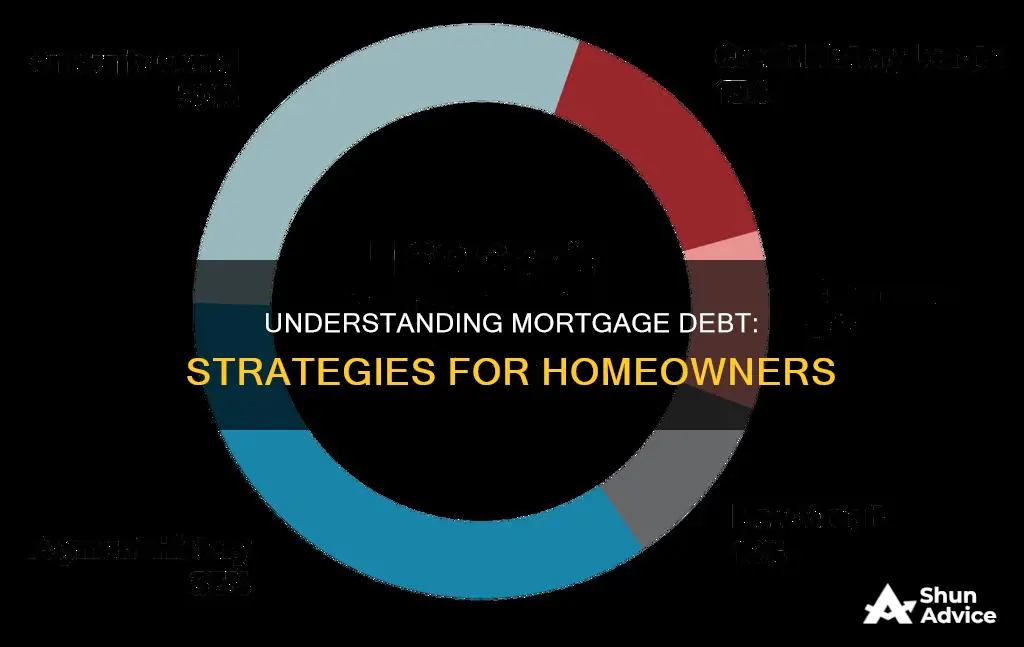
Understanding how much you owe on your mortgage is crucial for managing your finances and planning ahead. The amount you borrow is called the principal or mortgage balance, and it represents the original sum of money lent to you. Over time, you pay down the principal, reducing the amount you owe. In addition to the principal, you also pay interest, which is what the lender charges for lending you money. At the beginning of your mortgage term, you owe more interest as your loan balance is high. As you pay down the principal, your interest payments decrease, and more of your monthly payments go towards paying off the principal. To calculate your remaining loan balance, you need to know the original loan amount, interest rate, length of the loan, and the number of months you have already paid. Online mortgage calculators can help you determine your remaining balance and how much you owe on your mortgage.
| Characteristics | Values |
|---|---|
| Original loan amount | The amount financed in a mortgage loan when purchasing a home |
| Remaining loan balance | The amount left to pay on the mortgage loan |
| Loan term | The amount of time it will take to pay off the debt |
| Home equity | The difference between the value of the home and how much is owed on it |
| Monthly payment | The amount paid each month, which includes interest, taxes, insurance, and private mortgage insurance (PMI) |
| Interest | The percentage of the loan amount charged by the lender |
| Principal | The original sum of money lent |
What You'll Learn

Calculating your mortgage balance
Your monthly mortgage payments will cover the interest first, with the remainder going towards the principal. Over time, as the outstanding principal declines, the interest costs will also fall, and a greater proportion of your payments will go towards the principal. This means that, with each successive payment, you will pay less towards interest and more towards the principal.
There are several online mortgage balance calculators available, which will provide quick and accurate results. To use these, you will need to input the original loan amount, the interest rate, the length of the loan, and the number of months you have already paid. The calculator will then determine your remaining balance. Some calculators also allow you to enter a future payment date to see where your loan will be at a certain point in the future.
If you do not wish to use an online calculator, you can also calculate your remaining loan balance manually. To do this, subtract the amount you have already paid towards the principal from the original loan amount. This will give you the principal amount you still owe. For example, if your original loan was for $320,000, with a 6% interest rate over 30 years, and you have already paid $92,887.64 in interest and $22,226.06 towards the principal over 60 months, you will subtract the $22,226.06 you have paid towards the principal from the original loan amount of $320,000, leaving you with a remaining balance of $297,773.94.
It is important to remember that your mortgage balance is not the same as your mortgage payoff amount. The payoff amount will be higher than your mortgage balance, as it includes additional fees required by the lender to close out the mortgage.
Generate Mortgage Leads: Strategies for Success
You may want to see also

How to pay off your mortgage early
The amount you borrow with your mortgage is called the principal or the mortgage balance. Each month, part of your monthly payment goes toward paying off the principal and part pays interest on the loan. Interest is what the lender charges you for lending you money. In the beginning, when your loan balance is still high, you owe more interest. As you pay down the principal, you owe less interest each month, and more of your monthly payment goes to paying down the principal.
- Make extra payments toward your principal balance. This will help you save money on interest and pay off your loan faster.
- If interest rates decline, you may be able to reduce the amount you pay toward interest by refinancing your mortgage.
- Reduce your loan term.
- If you have a low-interest mortgage, it may make more financial sense to invest as much as possible elsewhere.
- Make minimum mortgage payments and try to save enough to pay off the mortgage.
- Be diligent and intentional with your spending.
Making Mortgage Overpayments: A Guide to Getting Started
You may want to see also

Understanding the principal
The principal is the original sum of money lent to you by a lender. It is the amount you borrow with your mortgage and is also referred to as the mortgage balance. This is separate from the interest, which is what the lender charges you for lending you the money.
At the beginning of your mortgage term, you owe more interest because your loan balance is high. Most of your monthly payments will go towards paying off this interest, with the remainder going towards the principal. Over time, as you pay down the principal, you owe less interest each month because your loan balance is lower. This means that more of your monthly payments will go towards paying off the principal.
Your remaining loan balance is the amount you have left to pay on your mortgage loan. To calculate this, you need to know the loan amount, the interest rate on your loan, the length of your loan, and how many months you have already paid. You can then subtract the amount you have paid towards the principal from the original loan amount to get your remaining balance.
Making extra payments on the principal balance of your mortgage can help you pay off your mortgage debt faster and save money on interest. For example, if you have a remaining balance of $350,000 on a 30-year fixed-rate mortgage and you increase your monthly payment by $1,000, you could pay off your home nearly 16 years faster and save almost $156,000 in interest.
Moving Your Mortgage: A Guide to Smooth Transitioning
You may want to see also

Interest rates and how they work
Interest rates are the percentage of interest charged relative to the principal. They are what lenders charge borrowers for lending them money. Interest rates are typically noted on an annual basis and are expressed as an annual percentage rate (APR).
Interest rates reflect the cost of borrowing money. When a loan is issued, the lender is taking on the risk that the borrower may not pay it back. Thus, interest provides compensation for bearing this risk. Interest rates also protect lenders against future rises in inflation. Since money is lent in the present, the prices of goods and services may increase by the time the lender is paid back, decreasing the money's original purchasing power.
The federal funds rate, or the rate that institutions charge each other for short-term loans, affects the interest rate that banks set on the money they lend. This rate trickles down into other short-term lending rates. The Federal Reserve influences these rates with "open market transactions", which involve the buying or selling of previously issued US securities. When the government buys more securities, banks have more money to lend, and interest rates decrease. Conversely, when the government sells securities, banks have less money to lend, and interest rates increase.
An increase in the demand for money or credit will raise interest rates, while a decrease in demand for credit will decrease them. Similarly, an increase in the supply of credit will reduce interest rates, while a decrease in the supply of credit will increase them. Inflation can also affect interest rates. The higher the inflation rate, the more interest rates are likely to rise as lenders will demand higher interest rates to compensate for the decrease in the future purchasing power of the money they are paid.
Transferring Your Mortgage: Navigating Away from Selene
You may want to see also

Additional monthly costs
When you take out a mortgage, you will owe more interest at the beginning of your mortgage term because your loan balance is high. As you pay down the principal, you will owe less interest each month, as your loan balance decreases. This process is known as amortization.
In addition to the principal and interest payments, there are several other costs that may be included in your monthly mortgage payments. These additional costs can vary depending on your specific situation and the terms of your mortgage. Here are some common additional monthly costs associated with owning a home and having a mortgage:
Property Taxes: Depending on your location, you may be required to pay property taxes, which are typically calculated based on the assessed value of your home. These taxes are usually included in your monthly mortgage payments and are held in an escrow account by your lender, who then pays them on your behalf when they are due.
Homeowner's Insurance: This type of insurance protects your home against various risks, such as fire, theft, or natural disasters. Similar to property taxes, your homeowner's insurance may be included in your monthly mortgage payment and held in an escrow account.
Private Mortgage Insurance (PMI): If your down payment on the house was less than 20% of the home's purchase price, you typically need to pay for private mortgage insurance (PMI). PMI protects the lender in case you default on your loan. Once you have built up enough equity in your home (usually 20% of the home's value), you can request to have PMI removed from your monthly payments.
Homeowners Association (HOA) Fees: If you live in a community with a homeowners association, you may need to pay monthly or annual HOA fees. These fees cover the maintenance and upkeep of common areas and amenities within the community. HOA fees are typically not included in your mortgage payment, and you may need to pay them separately.
Maintenance and Repairs: As a homeowner, you are responsible for the upkeep and maintenance of your property. While not typically included in your monthly mortgage payment, it is important to budget for regular maintenance and unexpected repairs. This can include costs such as lawn care, plumbing issues, or appliance repairs.
To calculate your total monthly mortgage payment, including these additional costs, you can use online mortgage calculators or consult with a financial advisor or lender. By understanding all the costs associated with your mortgage, you can make more informed financial decisions and ensure you are prepared for the ongoing expenses of homeownership.
Making Woolwich Mortgage Overpayments: A Step-by-Step Guide
You may want to see also
Frequently asked questions
There are several ways to find out how much you owe on your mortgage. You can use a mortgage calculator, which will require you to input the loan amount, the interest rate, the length of the loan, and the number of months you have already paid. You can also call your mortgage company to ask for your mortgage balance, or wait for their annual statement, which they will send electronically or by mail. If you bank with AIB, you can see your mortgage balance through your Internet or Mobile Banking.
A mortgage balance is the amount owed at a particular moment in time during the mortgage loan term. It is calculated by subtracting the amount you have paid toward the principal from the original loan amount.
You can use a formula to calculate your monthly mortgage payments manually, or you can use a mortgage calculator. The formula is quite complicated and requires you to know the period interest rate and the total number of payments in the life of the loan.







